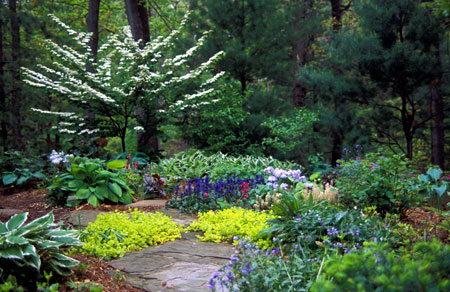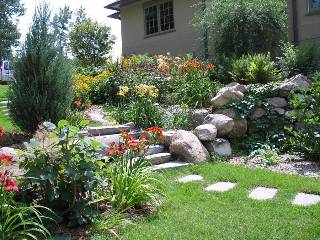On Lawns: To Have or Have Not and Anything In Between
By George Graine, Fairfax Master Gardener
“There is not a sprig of grass that shoots uninteresting to me.”
Thomas Jefferson letter to Martha Jefferson Randall (1790)

No front lawn
The venerable lawn has been a staple of homeowners since time immemorial, and it still is a tradition of long standing. For some homeowners who live in a community that requires a lawn, at least for the front yard, having a lawn is an absolute mandate. Furthermore, the lawn must be maintained in accordance with written rules. Not conforming may result in harsh treatment for those who do not follow the governing principles. For others, to have a lawn is an option and deserves much thought because of the effort and costs associated with lawn care.
To be sure, many books, articles and garden centers, as well as the internet, all praise having a lawn for a variety of reasons. No doubt this is true because sales of products necessary to maintain the lawn are good for business. Conversely, some books take issue with the long held belief that lawns must be a necessary part of your landscape. For example, Evelyn J. Hadden’s book, “Beautiful No-Mow Yards” argues this point. The contents noted in the subtitle of her book are extremely helpful for those who consider and/or desire to limit the amount of lawn on their property. Here you will read about “50 Amazing Lawn Alternatives.” In a similar vein, Pam Penick’s book “Lawn Gone!: Low-Maintenance, Sustainable, Attractive Alternatives for Your Yard” is another text to consider if you are teetering on the edge to have, partially have, or give up entirely on maintaining a lawn.
Not to be slighted, our own Virginia Tech Extension service has a lawn calendar and many publications that include recommendations, guidelines and practices regarding how to grow and maintain your lawn as a year-round fixture in your landscape. It is somewhat comforting to know that research-based information is readily available and that both sides of the lawn care issue can co-exist. Recognizing that for some people a lawn is a part of a landscape, you must also consider if continuing with high maintenance and associated high cost is worth it. Perhaps a lawn is necessary in order to have a yard that does more than provide a green swath. Here you may want a place to relax and play. Think of games such as croquet and badminton, picnics and other family and neighborly activity.

Shady area without lawn
For the past several years the forever lawn has been under attack. This has become a cause celebre by environmentalists and even some county governments regarding fertilizer restrictions and excessive water use which are seen as the main culprits. Yet the question still remains: Why have a lawn in the first place? Is having a lawn a good thing, as in need to have, nice to have? Or should it be replaced with something else as noted by several books in the paragraph above. Let’s consider some fair and balanced reasons as to why to have a lawn by considering some concrete (pardon the pun) facts. On the negative side are several requirements all of which are necessary in order for a lawn to thrive and survive such as:
- The need for water. Recommended is 1 inch per week whether by nature (rain) or your own irrigation with hose or sprinkler system.
- A lot of time and money! Consider: seeding, fertilizing, mowing, aerating, weeding, disease and pest control.

Combination lawn and garden
Now turn to a few positive aspects of a lawn. Aside from the beauty of a manicured lawn, there are many environmental benefits that can be attributed to a lawn. Without going into detail, here are a garden variety of several benefits for sustaining a healthy lawn. This is an incomplete list, but you should be able to capture the essence of why having at least some lawn is a good idea.
- Lawns absorb water so that runoff is minimized. At the same time, the lawn acts as a natural filter causing the stormwater to enter our groundwater with fewer pollutants.
- Lawns reduce heat when compared to asphalt. A lawn is a natural air conditioner because water that evaporates through the blades of grass creates the effect of cooling.
- These days, we often hear a lot about carbon. Without going into a scientific explanation, through the process of photosynthesis, lawns do remove carbon dioxide from the air and store it as organic matter. Then it is released as oxygen.
- Are you familiar with the term “grass cycling”? This means mowing your grass and leaving the clippings in place (no bag). It is a myth that this will result in a buildup of thatch — the stems of grass and not the blades. In fact, by leaving the grass clippings every time you mow, you will save on the cost of fertilizer that you put down on the lawn.
Space does not allow for detailed information on the many reasons to have a lawn or not. Instead, suffice to say, a healthy lawn will benefit you, your family and your neighborhood. At the same time, it is important for Harry and Harriet Homeowner to consider all the pros and cons for a lawn. After considering the cost, time, and environmental impact and location of the lawn, you also need to consider how all of these factors/criteria fit your needs and desires. So the question remains, to have or have not a lawn and anything in between? Do some research and then you will have a comprehensive idea on the direction you need to take.
Resources
Fall Lawn Care, Virginia Cooperative Extension
Maintenance Calendar for Cool-Season Turfgrasses in Virginia, Virginia Cooperative Extension
The Incredible Shrinking Lawn, George Graine, Fairfax Master Gardener
Redefining Your Lawn, George Graine, Fairfax Master Gardener